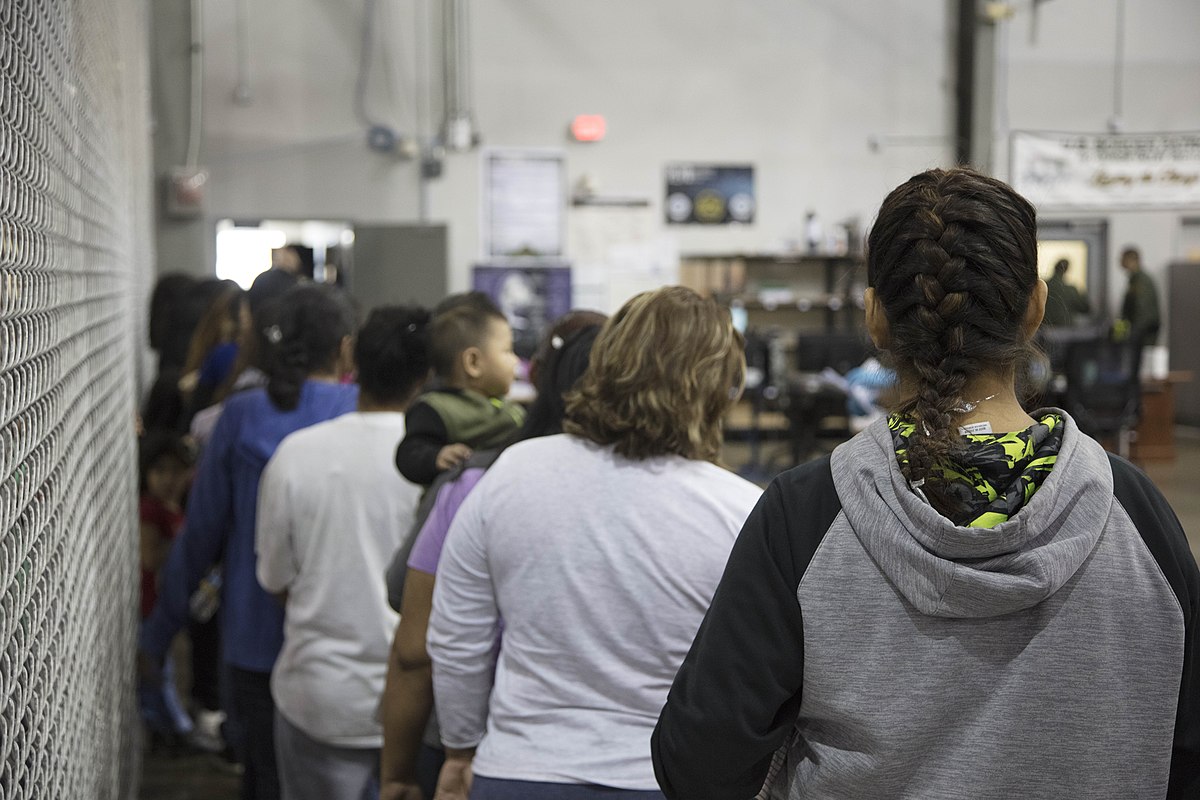At Oral Argument, Supreme Court Weighs Immigrant Detention
Mandatory immigration detention is an exception to the rule that confinement requires an individualized showing of flight risk or dangerousness. In 2016, the U.S. Court of Appeals for the Ninth Circuit narrowed the scope of mandatory detention, ruling that some noncitizens—“aliens” under the Immigration and Nationality Act (INA)—could show that they were not flight risks or dangerous and therefore should be released pending an immigration court hearing on the merits of their removal.

Published by The Lawfare Institute
in Cooperation With

Mandatory immigration detention is an exception to the rule that confinement requires an individualized showing of flight risk or dangerousness. In 2016, the U.S. Court of Appeals for the Ninth Circuit narrowed the scope of mandatory detention, ruling that some noncitizens—“aliens” under the Immigration and Nationality Act (INA)—could show that they were not flight risks or dangerous and therefore should be released pending an immigration court hearing on the merits of their removal. The government appealed, and last week, the Supreme Court heard oral argument in the case, now called Sessions v. Preap. (See Kevin Johnson’s take on the oral argument here.)
The Supreme Court should affirm the Ninth Circuit—but it should require that the noncitizen seeking release must show colorable grounds for contesting removal or obtaining other relief under the INA. Application of this substantive stake test will avoid constitutional problems while vindicating Congress’s concern with noncitizens’ appearance in immigration court.
The INA provision at issue in Preap is 8 U.S.C. §1226(c)(1), which requires immigration detention “when the alien is released” from prison or other custody where the noncitizen had been held based on conviction for a wide range of crimes, from crimes of violence and theft to possession of marijuana above a set threshold. Under the INA, each of these convictions can result in the noncitizen’s removal. As Justice Brett Kavanaugh noted during last week’s argument, Congress enacted the provision in 1996, as part of the Illegal Immigration Reform and Immigrant Responsibility Act, because legislators believed that some noncitizens had failed to appear at removal hearings, thereby frustrating immigration enforcement. Section 1226(c)(1) mandates detention of any lawful permanent resident (LPR) such as Mony Preap—the child of Cambodians fleeing the Khmer Rouge regime—who was born in a refugee camp and became an LPR in 1981. Immigration officials detained Preap some time after his convictions for possession of marijuana.
While Congress’s concern with some noncitizens’ failure to appear was legitimate, mandatory detention has also had harsh consequences. At last week’s argument, virtually every justice acknowledged that immigration officials have on occasion detained noncitizens for lengthy periods—sometimes stretching into years. Because of the vast sweep of Section 1226(c)(1), detention has extended even to noncitizens with colorable arguments that their criminal convictions were not in fact grounds for removal or that they were eligible for relief such as cancellation of removal, which the INA provides to LPRs who have committed certain crimes but who also have accrued specific periods of time in continuous residence and LPR status.
The purpose and operation of cancellation of removal illustrate the harsh effects of mandatory detention on longtime LPRs like Preap, who in fact ultimately received cancellation of removal. (Other members of the plaintiff class in Preap continued his challenge). Cancellation recognizes longtime LPRs’ deep ties to the United States. Based on these compelling equities, cancellation is available as long as a noncitizen has not been convicted of serious charges such as theft, crimes of violence or drug-trafficking crimes that constitute “aggravated felonies” under the INA.
Defining an aggravated felony under the INA can be challenging; in last term’s Sessions v. Dimaya, the Supreme Court held that one prong of the definition of “crimes of violence” was unconstitutionally vague. (In Dimaya, Justice Elena Kagan wrote for the Court, joined by the three other liberal justices and Justice Neil Gorsuch). Under Section 1226(c)(1), a noncitizen may have to litigate this complex question while detained in a remote location, with reduced prospects for obtaining legal representation. That litigation may take years, particularly when, as in Dimaya, the Supreme Court ultimately has to decide the contested legal issue. In a perverse effect of the mandatory detention regime, noncitizens with the best cases on the merits may spend the longest time in detention.
In Preap, the noncitizen class members argue that Section 1226(c)(1)’s “when released” language tempers the harshness of mandatory detention. According to the Preap class members, the provision’s mandatory detention requirement does not apply unless immigration officials detain the noncitizen immediately upon his or her release from criminal custody. The Ninth Circuit decision in Preap held that the government had to “promptly” detain the noncitizen after release, reading a durational limitation into Section 1226(c)(1). This limit would benefit noncitizens whom the government failed to detain immediately, including those who have lived for years in the community without further encounters with the criminal justice system. Under the Ninth Circuit’s view, when immigration officials finally arrested those noncitizens and issued a Notice to Appear (NTA) for removal proceedings in immigration court, the respondents in those proceedings would be eligible for bond based on their showing that they did not constitute a flight risk and posed no danger to the community. At oral argument, Justice Sonia Sotomayor and Justice Kagan seemed most intent on retaining the Ninth Circuit’s immediacy standard.
The Ninth Circuit supported this view by invoking the text of 8 U.S.C. §1226 as a whole. Subsection (a) of this provision states that immigration officials generally have discretion regarding whether to release a noncitizen, subject to the limitations in subsection (c), which includes both the “when released” language and a list of criminal convictions that trigger mandatory detention. For mandatory detention to apply, according to the 9th Circuit, a noncitizen had to have been convicted of one of the crimes specified and have been arrested promptly upon release.
Also relevant to the Supreme Court’s consideration of Preap is the avoidance canon, which requires reading a statute to preserve its constitutionality when a fair reading of the legislation permits that result. In last term’s Jennings v. Rodriguez, the Supreme Court, in an opinion by Justice Samuel Alito, held that the INA required mandatory detention for noncitizens whose immigration arrest occurred immediately after their release from criminal custody. In contrast, for noncitizens who were not arrested by immigration officials immediately upon their release from criminal custody and thereby arguably fall outside Section 1226(c)(1)’s “when released” language, the statute is at least ambiguous. This creates room for the avoidance canon. At last week’s oral argument, Justice Stephen Breyer highlighted this feature of the case, which virtually every justice agreed was at least part of the backdrop for the court’s deliberations.
The government’s arguments against the Ninth Circuit’s holding invoked legislative text and purpose. In considering purpose, Justice Kavanaugh succinctly stated Congress’s view that the flight risk and dangerousness criteria routinely used in criminal bail and immigration bond proceedings were too amorphous to assure that the maximum possible number of noncitizens who had received NTAs would show up for their merits hearings in immigration court. Justice Kavanaugh noted that Congress was surely aware that requiring immediate arrest by immigration officials upon an individual’s release from criminal custody would often be impracticable, since many persons convicted of statutorily qualifying crimes, such as marijuana possession, might take a plea deal requiring little or no prison time. Because state and local authorities do not routinely notify federal immigration authorities in such cases, arresting that person immediately upon release would impose an onerous burden on strapped immigration officials that Congress may well not have intended. Strictly as a matter of statutory construction—leaving constitutional issues aside—it seems odd to assume that Congress went to the trouble of including a range of qualifying convictions that would trigger mandatory detention, only to set up immigration officials to fail in this effort.
Moreover, Justice Kavanaugh suggested, the Ninth Circuit’s rosy view of noncitizens’ appearance at trial did not adequately address Congress’s concerns. The length of time that noncitizens have spent in the community prior to receipt of an NTA for a removal hearing is not always a reliable indicator of a noncitizen’s actions post-NTA. Confronted with the real risk of removal, some noncitizens might elect to abscond rather than appear in immigration court. While monitoring and other alternatives to detention might work in the majority of cases, some noncitizens would fall through the cracks. The temptation to abscond might be particularly appealing to noncitizens without a colorable argument against removal on the merits. Facing the virtually certain outcome of removal, those individuals might choose flight.
Addressing this concern, Zachary Tripp of the Justice Department argued that Section 1226(c)(1)’s “when released” language merely requires that the immigration arrest should take place at some point after release from criminal custody, without the narrow focus on immediacy of the plaintiffs. Under the plaintiffs’ argument, even 48 hours would be too long an interval between release from criminal custody and immigration arrest. Justices Gorsuch, Kavanaugh and Alito, as well as Chief Justice John Roberts, pushed the plaintiffs’ attorney, Cecilia Wang of the ACLU, on this point.
Supporting this argument, the government relied heavily on United States v. Montalvo-Murillo, a Supreme Court decision holding that the government’s failure to meet a particular statutory deadline did not trigger a wholesale “loss of authority” to detain a suspect who was both dangerous and a flight risk. To hold otherwise would have granted that dangerous defendant a “windfall” that Congress did not intend. According to this view, the government’s authority to require the detention of a noncitizen under Section 1226(c)(1) would not lapse merely because the government could not immediately arrest the noncitizen. Responding to this point, Justice Breyer asserted that under the Ninth Circuit’s decision in Preap, a noncitizen would not get a “windfall” at all. The noncitizen would not be automatically released; to obtain bond, he or she would still have to show that he was not dangerous or a flight risk. In that sense, the Ninth Circuit’s decision was entirely consistent with Montalvo-Murillo.
Importantly, the justices did not appear to view the court’s decision in Chevron v. Natural Resources Defense Council as controlling. In Chevron, the court held that it would defer to an agency interpretation if, 1) the statute was ambiguous, and, 2) the agency interpretation was reasonable. In Preap, the government strenuously argued that application of Chevron would require deference to its position. Either the statute unambiguously supported the government’s position, or in the alternative the statute was at least ambiguous and the government was reasonable in asserting that the statutory phrase “when … released” means any time after release. However, the justices asked virtually nothing about Chevron deference; they appeared to think that their task was to determine for themselves what the statute meant, against the backdrop of the Constitution if that turned out to be applicable.
Predicting how the Supreme Court will rule based on oral argument is perilous, and Preap is no exception. A majority of justices seemed concerned that accepting either the plaintiffs’ or the government’s stark preferred positions would create problems. Chief Justice Roberts and Justices Kavanaugh, Gorsuch and Alito (possibly joined by Justice Clarence Thomas, who as usual remained silent) were troubled by the plaintiffs’ argument that arrest had to be immediate to justify mandatory detention. Yet each justice also acknowledged potential problems with protracted mandatory detention of noncitizens apprehended years after their release. Justice Breyer sought a middle course, suggesting either that the government should have a reasonable time to arrest (e.g., six months) or that any period of mandatory detention should end after six months, allowing the noncitizen to then make an individualized showing in favor of release. Justice Alito mused about the possibility of an as-applied challenge to the constitutionality of the statute by a noncitizen whose long period of time in the community presented a particularly compelling factor weighing against mandatory detention.
Based on my experience with immigration law, I’d suggest that the court could vindicate Congress’s concern and the constitutional rights of the LPRs affected by Section 1226(c)(1) by reading the provision as requiring immediate arrest, but then tailoring the determination of flight risk to Congress’s concerns. This approach would require that the noncitizen first show a substantive stake in immigration court proceedings on the merits. An individual could demonstrate such a stake by making a colorable argument that his conviction was not for an “aggravated felony” (such as a “crime of violence,” “theft offense,” or drug trafficking crime) and that he or she met the other requirements for cancellation of removal (involving time in the United States).
Noncitizens with such a substantive stake would be virtually assured to show up at their immigration court merits hearings. If they prevailed, as Preap ultimately did, they would no longer face the risk of removal. Absconding would trigger an in absentia removal order and the consequent loss of LPR status, along with a grim future of perpetually looking over their shoulders for immigration officials in pursuit. No reasonable noncitizen would embrace that trade-off.
Having shown a substantive stake in the immigration court merits hearing, a noncitizen would then move to the ordinary criteria for showing lack of dangerousness and absence of flight risk, including a track record of law-abiding behavior, a job, family ties, and other familiar factors. But the threshold inquiry into substantive stake would protect against needlessly long stays in detention while firming up the flight risk and dangerousness inquiries that Congress had believed were too open-ended to deliver consistent results.
The substantive stake approach would involve some tweaking of the traditional open-ended flight-risk and dangerousness determination entail in bail and bond hearings. That modest change is less disruptive to the statutory scheme than terminating mandatory detention after a period not chosen by Congress—such as six months in Justice Breyer’s formulation. Similarly, a substantive stake approach is superior to reading the “when released” language in Section 1226(c) to include a specific time interval for immigration arrest that the Supreme Court designates as “reasonable,” even though Congress again did not provide any such limit. Avoiding this judicial rewriting of the statute, the substantive stake approach also sidesteps the constitutional difficulties with requiring detention of LPRs who have clear incentives to appear and colorable arguments on the merits. Minimizing both constitutional difficulties and statutory disruption makes a strong case for the substantive stake approach.
Court-watchers will know by the end of June if the Supreme Court opts for this path, selects Justice Breyer’s “reasonable time” approach, or accepts the government’s position. The interplay of statutory, administrative law, and constitutional issues makes the precise outcome more unpredictable than in other cases with fewer variables. For example, Justices Thomas, Alito, Gorsuch, and Kavanaugh, joined by Chief Justice Roberts, could decide that Chevron deference applied after all, and determine that the statute was ambiguous and the government’s view was reasonable. That result would signal deference in the immigration realm, although the result’s relevance in other settings, such as government efforts to regulate the environment, might be more uncertain. The court could postpone decision of constitutional issues and rule only on the statutory issue, as Justice Alito seemed to favor.
Alternatively, the four liberal Justices and at least one of the conservatives could form a majority favoring Justice Breyer’s “reasonable time” argument. That outcome would suggest that at least one of the conservative Justices was open to reading some conception of reasonableness into the statute. Under this approach, a “textualist” reading of statutes starts with statutory language but can also then import background understandings such as reasonableness.
Adopting the “substantive stake” test suggested in this post would read the statutory phrase “when … released” narrowly as meaning immediate arrest, but would then interpret the traditional factor of flight risk more strictly to require that the noncitizen as a threshold matter show a colorable case on the merits of removal. That approach would signal a commitment to individualized adjudication, but inform that adjudication with an appreciation for the practicalities of immigration law and enforcement. In any case, the court’s outcome and reasoning will tell us much about decisionmaking in the post-Kennedy Supreme Court.


.jpg?sfvrsn=8253205e_5)


